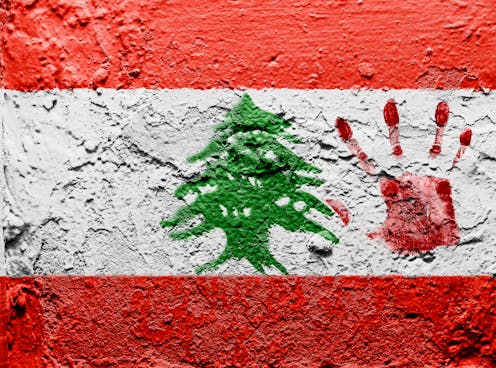
The assassination of Hezbollah’s leader, Hassan Nasrallah, in September sent shock waves through the Middle East and beyond. Nasrallah had evolved into the very embodiment of Hezbollah over his 32 years in charge, and had established himself as a key figure in Iran’s so-called axis of resistance.
At the height of his influence, Nasrallah was so widely admired from North Africa to Iran that shops sold DVDs of his speeches, cars were embellished with his image, and many Lebanese even used his quotes as ringtones.
He is not the first sectarian leader to have been assassinated in Lebanon. And on each occasion the killings have intensified sectarian tensions in the country and have jeopardised social stability. The impact of Nasrallah’s death will, in my opinion, probably be no different.
His killing could destabilise the fragile balance of power in the country. And it could also trigger a reshuffling of political alliances within Lebanon’s complex sectarian power-sharing framework that was established in 1990 after the end of the civil war.
In 1977, the leftist leader of the Druze community, Kamal Jumblatt, was assassinated by two unidentified gunmen in his stronghold in the Shouf mountains of central Lebanon. Many of his followers believed they knew who was responsible, and channelled their anger toward Lebanon’s Christian community.
Security officials reported that more than 250 Christians were killed in revenge, many brutally, with their throats cut by Druze assailants. At least 7,000 Christians fled their villages after the killings, with around 700 of them travelling to the presidential palace in Baabda, a suburb of Beirut, to request government protection.
This spell of fighting marked a significant escalation of sectarian violence during the civil war, and resulted in a persistent cycle of retaliation, deepening division and entrenched sectarian identities.
The world is watching the US election campaign unfolding. Sign up to join us at a special Conversation event on October 17. Expert panellists will discuss with the audience the upcoming election and its possible fallout.
Then, in June 1982, a powerful bomb explosion killed Lebanon’s Maronite Christian president, Bashir Gemayel. The assassination was carried out by two members of the Syrian Social Nationalist party, reportedly under orders from Syria’s then president, Hafez al-Assad.
The next day, Israeli troops entered west Beirut in support of the Phalange, a Lebanese Christian militia that blamed the Palestinian Liberation Organisation (PLO) for Gemayel’s death. Israel had earlier that month launched a massive invasion of Lebanon to destroy the PLO, which had been carrying out attacks on Israel from southern Lebanon.
Knowing that the Phalangists sought revenge for Gemayel’s death, Israeli forces allowed them to enter the Shatila refugee camp and the adjacent Sabra neighbourhood in Beirut and carry out a massacre a few months later. Lebanese Christian militiamen, in coordination with the Israeli army, killed between 2,000 and 3,500 Palestinian refugees and Muslim Lebanese civilians in just two days.
Scores of witness and survivor accounts say women were routinely raped, and some victims were buried alive or shot in front of their families. Women and children were crammed into trucks and taken to unknown destinations. These people were never seen again.
Following the end of Lebanon’s civil war, there was a period of relative stability as a delicate balance of power was established between Lebanese sects. But a car bomb in downtown Beirut in 2005 killed the country’s former prime minister, Rafic Hariri, and again altered the dynamics of sectarian rivalry in Lebanon.
Lebanon lost one of its central figures, while fury over Syria’s alleged involvement in Hariri’s murder raised international pressure on Syria to end its 29-year occupation. The withdrawal diminished Syria’s influence as the primary mediator in the country, and the underlying tension between the two main sectarian groups vying for power, the Sunnis and Shia, surfaced abruptly.
Lebanon experienced 18 months of political deadlock and protests, with Hezbollah and its allies pushing for a veto power in the government. Hostilities intensified and violence became a constant threat.
Then, in May 2008, the Lebanese government attempted to remove a Hezbollah-aligned security officer and investigate the organisation’s private communications network. This ignited fierce clashes between supporters of the government and the Hezbollah-led opposition.
Hezbollah and its allies occupied west Beirut and at least 71 people, including 14 civilians, were killed over the following fortnight.
Hezbollah steadily expanded and enhanced its military capabilities over the next ten years. And it also emerged as a powerful regional player by joining Iran and Russia in supporting Bashar al-Assad’s regime in the Syrian civil war.
The organisation assumed an increasingly central role in Lebanese politics, and secured a majority of seats in the 2018 parliamentary elections.
What happens now?
Lebanon’s modern history is rife with conflict. The assassination of Nasrallah marks the latest in a series of bloody milestones that have served as sharp turning points – and even transformational moments – in Lebanon’s sectarian politics.
Christian and Sunni factions in Lebanon have for years viewed Hezbollah as effectively commandeering the state, leveraging its powerful military wing and Iranian backing. With Hezbollah now visibly weakened in the absence of its powerful and charismatic leader, this longstanding power dynamic may be set for a shift.
There are signs that divisions are already deepening. Videos from Tripoli, a predominantly Sunni city in northern Lebanon, show residents dancing in the streets in celebration of Nasrallah’s death. Other videos show people removing Hezbollah stickers from the vehicles of displaced Shias.
Meanwhile, Hezbollah supporters have pledged retaliation for Nasrallah’s elimination. Lebanon once again finds itself on the verge of fierce sectarian tension and instability.
This research is carried out as part of the XCEPT programme, which is funded by UK International Development from the UK government. The views expressed do not necessarily reflect the UK government’s official policies.
This article was originally published on The Conversation. Read the original article.







